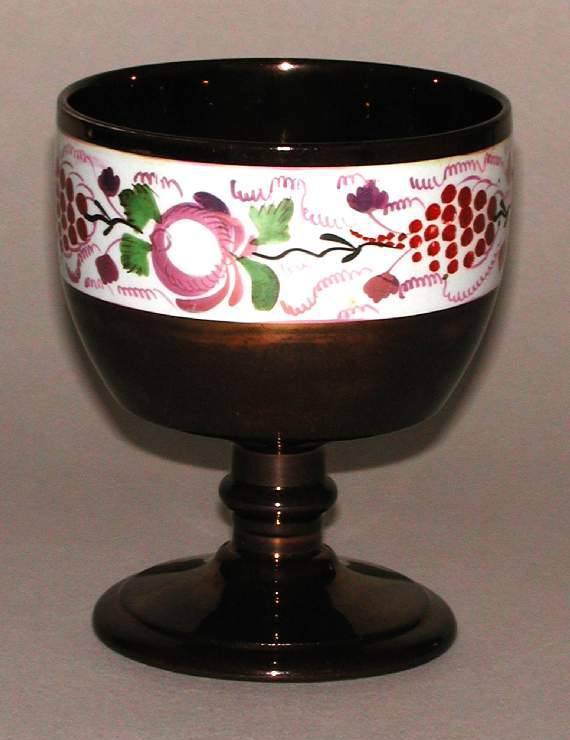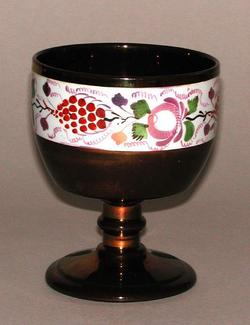Current Location: In storage
Titles
‘Copper’ goblet’
Maker(s)
Production:
Unidentified factory
(Probably)
Entities
Categories
Description
Red earthenware, glazed and decorated with copper and pink lustres, and green, red and black enamels.
Goblet, with a deep, rounded, flat-bottomed bowl, short stem with a central anulet, and stepped and slightly domed circular foot. Decorated overall with copper lustre, except for a reserved band of white slip round the bowl, which is decorated with a black stem bearing pink lustre roses, pairs of green leaves, red berries and pink lustre tendrils. The underside is indented, glazed and lustres, with a foot-rim.
Notes
History note: G.H.W. Rylands
Legal notes
Given by G.H.W. Rylands in memory of his mother, Betha Wolferstan Rylands.
Measurements and weight
Height: 10.6 cm
Acquisition and important dates
Method of acquisition: Given
(1997)
by
Rylands, G.H.W.
Dating
19th Century
Circa
1830
CE
-
1840
CE
Note
English lustreware was commercially produced from c.1805 and popular throughout the first half of the 19th Century. Staffordshire potters were the first and largest producers, though similar wares were also made in other regions and pink lustreware is often particularly associated with Sunderland. Minute amounts of gold were used to produce copper, gold, pink or purple lustre, depending on the type of clay, lustre formula, number of layers and firing temperature; platinum was used to mimic silver. Copper lustre was a popular choice for highlighting moulded wares and for broad borders covering the neck rim and handle. By c.1830 it was used to mimic the metal itself, by dipping the whole vessel into the lustre, perhaps with a relief or reserved band of decoration.
Most lustreware was made for everyday use, and factory markings are rare.
Components of the work
Decoration
composed of
enamels
( green, red and black)
lustre
( with copper and pink)
Foot
Diameter 7.3 cm
Bowl
Diameter 8.8 cm
Materials used in production
Red earthenware
References and bibliographic entries
Identification numbers
Accession number: C.59-1997
Primary reference Number: 75601
Stable URI
Audit data
Created: Saturday 6 August 2011
Updated: Tuesday 30 April 2024
Last processed: Tuesday 29 July 2025
Associated departments & institutions
Owner or interested party:
The Fitzwilliam Museum
Associated department:
Applied Arts





